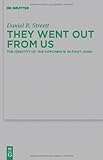About the Series
This is part of an ongoing series where I discuss resources that should be developed to aid teachers and students in acquiring Koine Greek communicatively. In this installment, I address what I think is perhaps the most important resource needed if a communicative method is to gain a foothold in Greek classes on a seminary and college level.
The Need for a Communicative Curriculum
Wherever I have advocated for a communicative approach to teaching Koine Greek, the response has been overwhelmingly positive. There are always a few dissenters, but by and large people are very open to the concept. This is especially true of the younger generation of graduate students, adjuncts, and junior faculty who typically handle the lion’s share of basic Greek teaching. But, what I hear time and again is that they do not feel comfortable just striking out on their own. Their Greek is simply not adequate to the task.
 So, the choice is a virtual no-brainer: Spend every waking moment developing materials and class plans for a teaching method that will likely just earn me the scorn of peers and senior faculty . . . OR Use Mounce’s time-tested and bestselling curriculum with pre-written quizzes, exercises, workbook, laminated guide, flashcards and supporting website. Hmmm. . . yeah, unless you’re crazy like me, you’ll choose the latter every time. What I hear, then, from interested Greek teachers is that they would give communicative teaching a try, but they need the same kind of supporting resources that the grammar-translation method supplies.
So, the choice is a virtual no-brainer: Spend every waking moment developing materials and class plans for a teaching method that will likely just earn me the scorn of peers and senior faculty . . . OR Use Mounce’s time-tested and bestselling curriculum with pre-written quizzes, exercises, workbook, laminated guide, flashcards and supporting website. Hmmm. . . yeah, unless you’re crazy like me, you’ll choose the latter every time. What I hear, then, from interested Greek teachers is that they would give communicative teaching a try, but they need the same kind of supporting resources that the grammar-translation method supplies.
 What a Comprehensive Curriculum Would Include
What a Comprehensive Curriculum Would Include
I’ve discussed in past posts the need for self-study tools like a Rosetta Stone-type software package for Koine Greek, a Koine Pimsleur-style conversational audio course, a basic picture dictionary and English to Greek dictionary, but here I want to talk about a complete package for in-class instruction. The idea is that with this package a teacher could, with minimal oral Greek ability, conduct a communicative class where the majority of class time would be spent in Greek. Here’s what such a package would need:
- Most importantly, a daily lesson plan that would:
- explain for the teacher what the target structures or topics would be for the day (e.g., names, numbers, family members, foods, weather, “can you . . .”)
- provide a list of the vocabulary to be covered in each lesson
- have a chart or summary of the grammatical forms to be used that day
- contain a guide that tells what homework, lab work, and out-of-class group practice activities should be assigned for each lesson
- give an overview of how class time should be spent, e.g.: do 5 minutes of pronunciation practice, 5 minutes of flashcard work, 30 minutes of TPR, 10 minutes of dictation, 10 minutes of conversational practice, 20 minutes of group work, etc.
- provide a step-by-step “script” for conducting class—this would be especially important for the TPR, TPRS and conversational portions of class time, where it is important to review previously covered words and structures at spaced intervals—it’s much better to have this mapped out ahead of time than to try to come up with it on the fly
- Obviously, for the daily lesson plan to be effective, the curriculum package would need to include as many of the following as possible:
- A textbook—preferably one like Puntos de Partida or Kontakte, both of which are best-selling textbooks that are meant to supplement the communicative classroom experience. Take a look at some of the sample chapters and be amazed at the amount of pictures and activities and how much of the book is already in L2 at the beginning: Ch. 1 of Puntos and Ch. 1 of Kontakte. I have an upcoming post planned comparing typical Greek textbooks to modern language ones, so keep your eyes out for that.
- Games for in-class use and lab use.
- Worksheets for students to do in class and as homework.
 Short quizzes geared to the lesson plan—these are important for giving students quantifiable feedback and a sense of accomplishment.
Short quizzes geared to the lesson plan—these are important for giving students quantifiable feedback and a sense of accomplishment.- Midterm and final exams that are geared to the lesson plan.
- Easy stories to be read in class and as homework. Comprehension questions could be included as part of the homework.
- Picture slides to be used in class for practicing vocabulary or telling stories.
- Flash cards, preferably digital with audio and images, for students to use to review vocabulary.
- Videos that give TPR instructions so that students can practice responding to instructions in the privacy of their own homes or dorm rooms.
- A practice guide that gives students ideas of how to practice their Greek outside of class. For example, if you require students to meet regularly outside of class in groups of three, they can practice just about anything that was done in class, as long as they have the materials. It might be good to have TPR scripts included in this packet so that students could give instructions to each other.
 Labels for common items that could be used in a language lab or given to students to put up in their homes in order to create an immersive environment.
Labels for common items that could be used in a language lab or given to students to put up in their homes in order to create an immersive environment.- A guide to developing a language lab and stocking it with all the materials it needs.
- I think it would also be helpful to have included in the curriculum package a basic introduction to Second Language Acquisition theory. This would give the teacher a theoretical framework that would a) explain what it means to know a language and to read a language, b) summarize the history of SLA research, c) allow them to understand what activities aid acquisition and which ones don’t, d) give them an idea of what to expect from the students in terms of proficiency and reading ability at each stage of the course, and e) help them explain communicative teaching to fellow teachers who only know the grammar-translation method.
Conclusion
In future posts, I hope to elaborate on how some of these elements would work. For now, what else do you think should be included in a teacher’s package? Do you think Greek professors would be willing to give communicative teaching a try if such a package were available? Give us your feedback in the comments section below!





Hey i just want to thank you for posting the biblical language center link I ordered their greek text books and im learning so much and its really fun So really thank you and i love this Blog
When a new curriculum is going to be adopted or if there is material needed for an especific area, many teachers get together from different grade levels to provide their input and ideas. Would it be difficult for a group of Professors and Instructors of Koine Greek to get together to work on an ambitious project such as this? And if getting together is not possible, communication via email would be also a good idea. I think many of us have pieces of what you describe here in our computers. I will take what I have to the Immersion Workshop at Fresno next Summer.
Hi Professor, I am but a mere first year student ( and a part tieme one at that) and have yet to tackle the greek, looks so intimidating. Where does one start if you want to educate yourself in the greek? I will have to do Greek next year sometime but I want to be ready for it before I tackle the subject officially!
Regards
Simon, I would start by acquiring Randall Buth’s materials from the Biblical Language Center and working through them. Keep an eye on this blog, too, since I hope to address this subject repeatedly in the coming months.
Dear Daniel,
I have a good friend (Pastor Sam Hull) who is affiliated with Criswell and who’s brother works there. Your ideas are impressive! I have studied Koine Greek of and on for many years now, and used to use the modern pronunciation (in the 1980s), but have recently switched back to the Erasmium. There is the Restored pronunciation as well, but one can good arguments for all.
I remember clearly seeing a place n which students interact with the teacher speaking on ly in Koine Greek. I can’t find it now and wondered if you are familiar with this,
Thanks
Paul
Hello there, I would like to contribute to the learning process of the Greek language by displaying my greek quizlet (above) sets from my blog.Please visit.